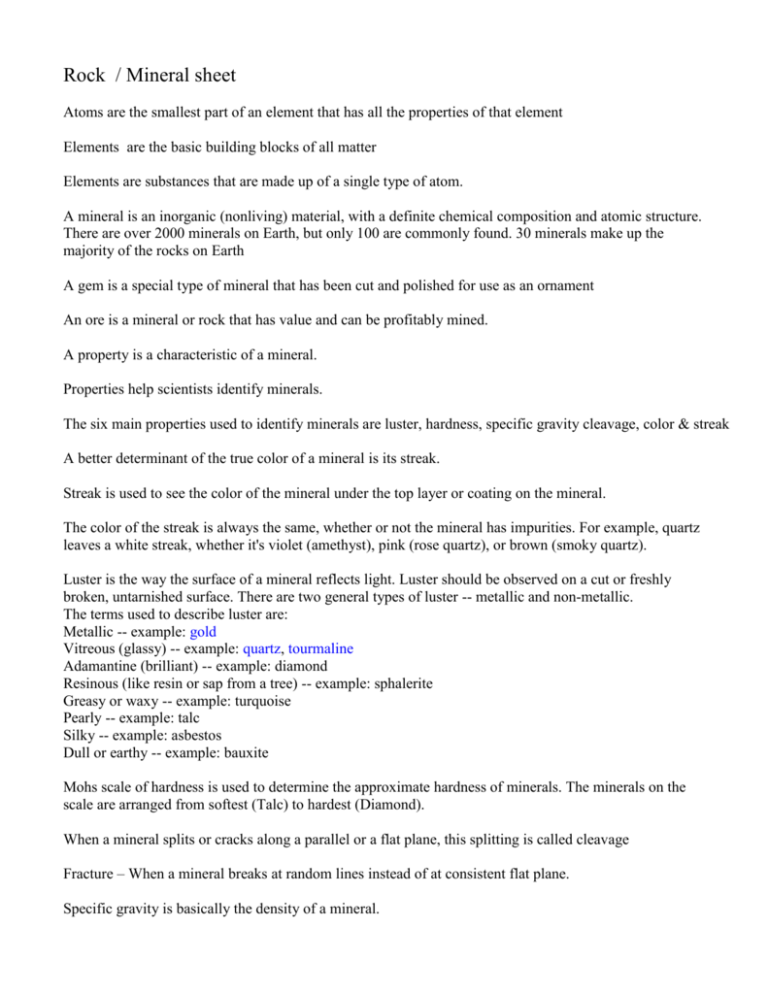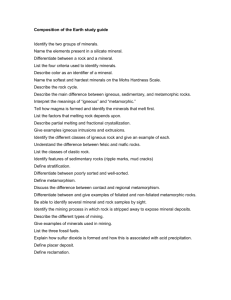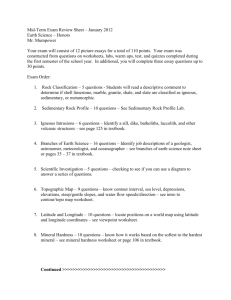Rocks differ from minerals because rocks are made of
advertisement

Rock / Mineral sheet Atoms are the smallest part of an element that has all the properties of that element Elements are the basic building blocks of all matter Elements are substances that are made up of a single type of atom. A mineral is an inorganic (nonliving) material, with a definite chemical composition and atomic structure. There are over 2000 minerals on Earth, but only 100 are commonly found. 30 minerals make up the majority of the rocks on Earth A gem is a special type of mineral that has been cut and polished for use as an ornament An ore is a mineral or rock that has value and can be profitably mined. A property is a characteristic of a mineral. Properties help scientists identify minerals. The six main properties used to identify minerals are luster, hardness, specific gravity cleavage, color & streak A better determinant of the true color of a mineral is its streak. Streak is used to see the color of the mineral under the top layer or coating on the mineral. The color of the streak is always the same, whether or not the mineral has impurities. For example, quartz leaves a white streak, whether it's violet (amethyst), pink (rose quartz), or brown (smoky quartz). Luster is the way the surface of a mineral reflects light. Luster should be observed on a cut or freshly broken, untarnished surface. There are two general types of luster -- metallic and non-metallic. The terms used to describe luster are: Metallic -- example: gold Vitreous (glassy) -- example: quartz, tourmaline Adamantine (brilliant) -- example: diamond Resinous (like resin or sap from a tree) -- example: sphalerite Greasy or waxy -- example: turquoise Pearly -- example: talc Silky -- example: asbestos Dull or earthy -- example: bauxite Mohs scale of hardness is used to determine the approximate hardness of minerals. The minerals on the scale are arranged from softest (Talc) to hardest (Diamond). When a mineral splits or cracks along a parallel or a flat plane, this splitting is called cleavage Fracture – When a mineral breaks at random lines instead of at consistent flat plane. Specific gravity is basically the density of a mineral. Rocks differ from minerals because rocks are made of two or more different minerals that have been: 1. cemented together, or 2. Changed by heat and pressure, or 3. melted and cooled together. Rocks are classified by the way they were formed The three main rock classifications are : 1. Igneous 2. Metamorphic 3. Sedimentary Igneous comes from the Latin word ignis which means "fire” so, rocks that formed from magma which is fiery hot are called igneous rocks. There are two main types of igneous rocks Intrusive – Igneous rocks that formed inside the Earth. Extrusive – Igneous rocks that cooled on the Earth’s surface Crystals that cool intrusively are larger than extrusive crystals, because they cool slower, giving them more time to grow. Metamorphosis means change (think caterpillar to butterfly). Rocks that are changed into a new type of rock due to heat and pressure deep in the Earth are called metamorphic rocks. There are two main types of metamorphic rocks: Foliated – Metamorphic rocks in which the minerals have been flattened and pushed down into parallel layers. The bands in foliated metamorphic rock look like pages in a book. NON-FOLIATED - Metamorphic rocks that do not display layers. Rocks that are formed from the cementing together of small pieces of rocks, minerals or shells (Sediments) are called sedimentary rocks If any rock, sedimentary, metamorphic, or igneous becomes exposed it will start to become weathered. The weathered bits (sediments) eventually are deposited and form sedimentary rock. If any rock, sedimentary, metamorphic, or igneous comes in contact with intense heat and pressure it will change and become a metamorphic rock. If any rock, sedimentary, metamorphic, or igneous, melts, (becomes magma), cools and hardens, it has become an igneous rock.






